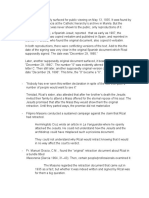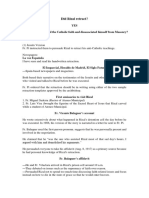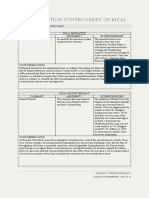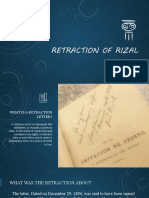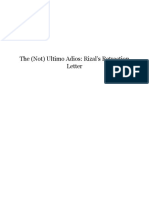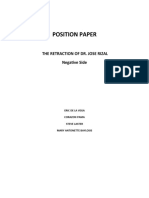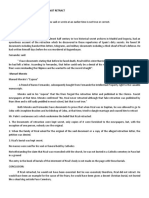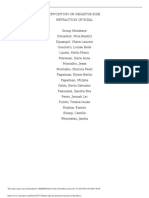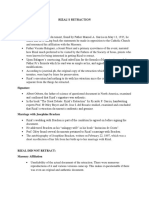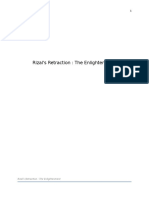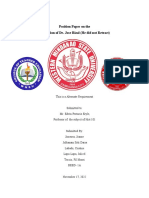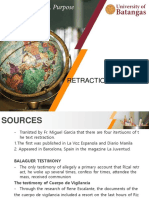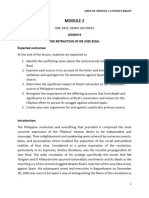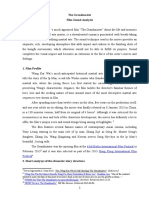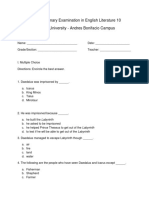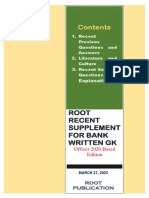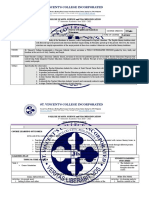Jose Rizal's retraction: the controversy
By Dr. Raul Nidoy
One of my contributions at Wikipedia, in the article on Jose Rizal, which I first wrote in November 2009. It is written in accord
with Wikipedia's NPOV policy, meaning Neutral Point of View.
Several historians report that Rizal retracted his anti-Catholic ideas through a
document which stated: "I retract with all my heart whatever in my words, writings,
publications and conduct have been contrary to my character as a son of the Catholic
Church."[note 13] However, there are doubts of its authenticity given that there is no
certificate of Rizal's Catholic marriage to Josephine Bracken.[45] Also there is an
allegation that the retraction document was a forgery.
After analyzing six major documents of Rizal, Ricardo Pascual concluded that the
retraction document, said to have been discovered in 1935, was not in Rizal's
handwriting. Senator Rafael Palma, a former President of the University of the
Philippines and a prominent Mason, argued that a retraction is not in keeping with
Rizal's character and mature beliefs.[47] He called the retraction story a "pious
fraud."[48] Others who deny the retraction are Frank Laubach,[10] a Protestant
minister; Austin Coates,[31] a British writer; and Ricardo Manapat, director of the
National Archives.
Those who affirm the authenticity of Rizal's retraction are prominent Philippine
historians such as Nick Joaquin,[note 14] Nicolas Zafra of UP[50] León María Guerrero
III,[note 15] Gregorio Zaide,[52] Guillermo Gómez Rivera, Ambeth Ocampo,[49] John
Schumacher,[53] Antonio Molina,[54] Paul Dumol[55] and Austin Craig.[26] They take
the retraction document as authentic, having been judged as such by a foremost expert
on the writings of Rizal, Teodoro Kalaw (a 33rd degree Mason) and "handwriting
experts...known and recognized in our courts of justice", H. Otley Beyer and Dr. José I.
Del Rosario, both of UP.
Historians also refer to 11 eyewitnesses when Rizal wrote his retraction, signed a
Catholic prayer book, and recited Catholic prayers, and the multitude who saw him kiss
the crucifix before his execution. A great grand nephew of Rizal, Fr. Marciano Guzman,
cites that Rizal's 4 confessions were certified by 5 eyewitnesses, 10 qualified witnesses, 7
newspapers, and 12 historians and writers including Aglipayan bishops, Masons and
anti-clericals. One witness was the head of the Spanish Supreme Court at the time of his
notarized declaration and was highly esteemed by Rizal for his integrity. Because of
what he sees as the strength these direct evidence have in the light of the historical
method, in contrast with merely circumstantial evidence, UP professor emeritus of
history Nicolas Zafra called the retraction "a plain unadorned fact of history."Guzmán
attributes the denial of retraction to "the blatant disbelief and stubbornness" of some
Masons.To explain his retraction, Guzman said that the factors are the long discussion and
debate which appealed to reason and logic that he had with Fr. Balaguer, the visits of his mentors
�and friends from the Ateneo, and the grace of God due the numerous prayers of religious
communities.
Supporters see in the retraction Rizal's "moral courage...to recognize his
mistakes;"[52][note 16] his reversion to the "true faith", and thus his "unfading
glory;"[57] and a return to the "ideals of his fathers" which "did not diminish his stature
as a great patriot; on the contrary, it increased that stature to greatness."[60] On the
other hand, senator Jose Diokno stated, "Surely whether Rizal died as a Catholic or an
apostate adds or detracts nothing from his greatness as a Filipino... Catholic or Mason,
Rizal is still Rizal - the hero who courted death 'to prove to those who deny our
patriotism that we know how to die for our duty and our beliefs'."[61]
Notes 13 to 16
Me retracto de todo corazon de cuanto en mis palabras, escritos, impresos y
conducta ha habido contrario á mi cualidad de hijo de la Iglesia Católica: Jesus
Cavanna, Rizal's Unfading Glory: A Documentary History of the Conversion of Dr. José
Rizal (Manila: 1983) ^ Joaquin, Nick, Rizal in Saga, Philippine National Centennial
Commission, 1996:""It seems clear now that he did retract, that he went to confession,
heard mass, received communion, and was married to Josephine, on the eve of his
death". ^ "That is a matter for handwriting experts, and the weight of expert opinion is
in favor of authenticity. It is nonsense to say that the retraction does not prove Rizal's
conversion; the language of the document is unmistakable."[51] ^ The retraction, Javier
de Pedro contends, is the end of a process which started with a personal crisis as Rizal
finished the Fili.[58][59]
References:
^ Ildefonso T. Runes and Mameto R. Buenafe, The Forgery of the Rizal "Retraction" and
Josephine's "Autobiography" (Manila: BR Book Col, 1962) ^ "Rizal's Retraction: A Note
on the Debate, Silliman Journal (Vol. 12, No. 2, April, May, June 1965), pages 168–183".
Life and Writings of José Rizal. Retrieved September 9, 2009. ^ Rafael Palma, Pride of
the Malay Race (New York: Prentice Hall, 1949) ^ a b Ambeth Ocampo (2008). Rizal
Without the Overcoat. Anvil Publishing. ^ a b c Nicolas Zafra (1961). Historicity of
Rizal's Retraction. Bookmark. ^ Guerrero, León Maria III (1963). "The First Filipino: A
Biography of José Rizal". National Historical Institute of The Philippines, Manila. ^ a b
Gregorio Zaide (2003). Jose Rizal: Life, Works and Writings of a Genius, Writer,
Scientist and National Hero. National Bookstore. ^ Schumacher, John. "The Making of
a Nation: Essays on Nineteenth-Century Nationalism". ^ Molina, Antonio M. (1998).
"Yo, José Rizal". Ediciones de Cultura Hispánica, Madrid. ^ "Uncovering Controversial
Facts about José Rizal" (mariaronabeltran.com) ^ a b Marciano Guzman (1988). The
Hard Facts About Rizal's Conversion. Sinagtala Publishers. ^ a b Jesus Cavanna (1983).
Rizal's Unfading Glory: A Documentary History of the Conversion of Dr. Jose Rizal. ^
Javier de Pedro (2005) Rizal Through a Glass Darkly, University of Asia and the Pacific
^ "Evolution of Rizal's Religious Thought". ^ (1950-01-06). "Joint Statement of the
Catholic Hierarchy of the Philippines on the Book 'The Pride of the Malay Race'". CBCP
(Catholic Bishop's Conference of the Philippines) Documents. Retrieved on 2012-09-30.
^ Garcia, Ricardo P. (1964). "The Great Debate: The Rizal Retraction - Preface". R.P.
Garcia Publishing Co., Quezon City.
� The document of the retraction of Jose Rizal, too, is being
hotly debated as to its authenticity.
It was supposed to have been signed by Jose Rizal moments before his
death. There were many witnesses, most of them Jesuits. The document only
surfaced for public viewing on May 13, 1935. It was found by Fr. Manuel A.
Gracia at the Catholic hierarchy’s archive in Manila. But the original document
was never shown to the public, only reproductions of it.
However, Fr. Pio Pi, a Spanish Jesuit, reported that as early as 1907, the
retraction of Rizal was copied verbatim and published in Spain, and reprinted
in Manila. Fr. Gracia, who found the original document, also copied it
verbatim.
In both reproductions, there were conflicting versions of the text. Add to
this the date of the signing was very clear in the original Spanish document
which Rizal supposedly signed. The date was “December 29, 1890.”
Later, another supposedly original document surfaced, it bears the date
“December 29, 189C”. The number “0” was evidently altered to make it look
like a letter C. Then still later, another supposedly original version came up. It
has the date “December 29, 1896”. This time, the “0” became a “6”.






